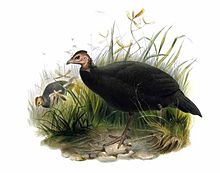Black guineafowl
| Black guineafowl | |
|---|---|
 |
|
| Scientific classification | |
| Kingdom: | Animalia |
| Phylum: | Chordata |
| Class: | Aves |
| Order: | Galliformes |
| Family: | Numididae |
| Genus: | Agelastes |
| Species: | A. niger |
| Binomial name | |
|
Agelastes niger Cassin, 1857 |
|
The black guineafowl, (Agelastes niger), is a member of the guineafowl bird family. It occurs in humid forests in Central Africa where it is often heard but seldom seen. It is a medium-sized black bird with a bare pink head and upper neck. Little is known of its behaviour.
The head and upper neck of an adult black guineafowl are unfeathered, revealing the pink skin. There is a crest of short downy feathers on the forehead and crown and the throat and lower neck have a scattering of downy feathers. The body and tail feathers are black with some paler speckled markings on the belly. Males have one to three spurs on their legs while females either have none or a single short spur. Juveniles are similar but have buff tips to the feathers on their upperparts, a speckled breast and white belly. The beak is greenish grey and the legs greyish brown. Males are usually slightly larger than females and measure about 42 centimetres (17 in) in length, weighing about 700 grams (25 oz). The call is a monotonous high-pitched "kwee" repeated at the rate of two to three notes per second. The alarm call is an even shriller sound repeated more rapidly.
The black guineafowl has been little studied. It is usually found in pairs or small groups and is a shy, elusive bird of the forest floor. It occurs in primary and secondary growth woodland, favouring parts with thick undergrowth but sometimes venturing out onto adjacent cultivated lands. It feeds on invertebrates such as ants, termites, millipedes and beetles, and also small frogs, seeds, berries and shoots. The nesting habits of this species are not known but the eggs are pale reddish brown, sometimes shaded with yellow or purple. It may breed in the dry season or possibly at any time of year.
The black guineafowl is native to West Central Africa south of the Sahara. Its range includes Nigeria, Cameroon, Equatorial Guinea, Gabon, Angola, the Central African Republic, the Republic of the Congo and the Democratic Republic of the Congo. The extent of its range is estimated to be 764,000 square kilometres (295,000 sq mi). It is found on the forest floor in primary and secondary tropical rainforest, especially with thick undergrowth, and in nearby cultivated croplands.
...
Wikipedia

